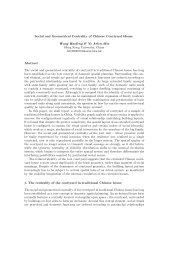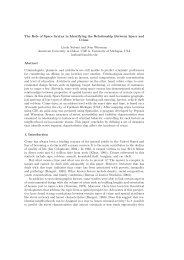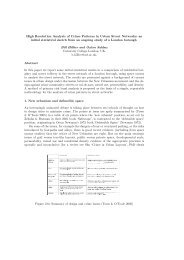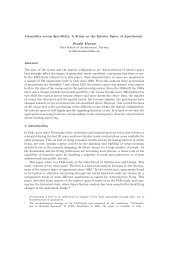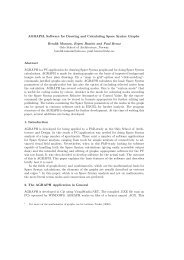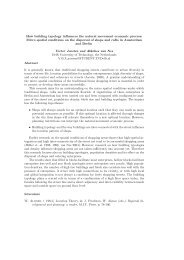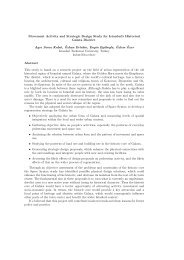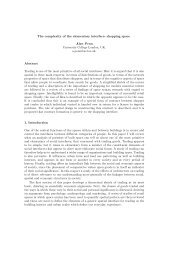The spatial behavior of residential burglars Manuel J.J. ... - TU Delft
The spatial behavior of residential burglars Manuel J.J. ... - TU Delft
The spatial behavior of residential burglars Manuel J.J. ... - TU Delft
Create successful ePaper yourself
Turn your PDF publications into a flip-book with our unique Google optimized e-Paper software.
432 <strong>Manuel</strong> J.J. López<br />
our crime series, we see that 4 out <strong>of</strong> 20 <strong>of</strong>fenders committed <strong>residential</strong> burglaries on the<br />
street where they lived. Two <strong>of</strong>fenders even committed burglaries in the homes <strong>of</strong> their<br />
former neighbors. <strong>The</strong>se facts are not in line with the theories that assume the existence<br />
<strong>of</strong> a buffer zone.<br />
7. Travel direction<br />
By only looking into the <strong>of</strong>fender’s range <strong>of</strong> operation, distance decay, and buffer zone,<br />
we make the implicit assumptions that <strong>of</strong>fenses are evenly distributed within the range <strong>of</strong><br />
operation and that the home <strong>of</strong> the <strong>of</strong>fender will be exactly in the middle <strong>of</strong> the <strong>of</strong>fence<br />
locations. We have seen however, that these assumptions are not correct. <strong>The</strong> <strong>of</strong>fender’s<br />
home address is <strong>of</strong>ten not exactly in the middle <strong>of</strong> the <strong>of</strong>fence locations and some distances<br />
contain more <strong>of</strong>fences than others. This can be caused by the non-random distribution<br />
<strong>of</strong> opportunity spaces, but it can also be caused by the fact that <strong>burglars</strong> have some<br />
favorite travel directions, for example, because the locations <strong>of</strong> their work, recreation<br />
and/or shopping happen to be in those directions. <strong>The</strong> presentation <strong>of</strong> Akkelies van Nes<br />
will deal with the possible influence <strong>of</strong> the built environment (and the related distribution<br />
<strong>of</strong> opportunity spaces) on the <strong>of</strong>fender’s <strong>spatial</strong> <strong>behavior</strong>. First, however, we will take a<br />
closer look into a possible alternative explanation; namely the <strong>of</strong>fender’s preference for a<br />
certain travel direction.<br />
According to Lundrigan and Canter (2001), the hypothesis about the <strong>of</strong>fender’s directional<br />
preference can best be tested by analyzing the angles created by the <strong>of</strong>fender’s<br />
home and his <strong>of</strong>fence locations. <strong>The</strong> hypothesis is confirmed when the angle is smaller<br />
than 90o (a sharp angle). If the angle is bigger than 90o, we must reject the hypothesis. In<br />
that case, we have found pro<strong>of</strong> that the <strong>of</strong>fender does not have any directional preference.<br />
Godwin (2000) follows a comparable approach and calculates the directional angle on the<br />
basis <strong>of</strong> the geographical degrees <strong>of</strong> longitude and latitude. Both studies show that serial<br />
killers and (in the case <strong>of</strong> Godwin’s study) serial rapists have a clear directional preference<br />
when committing <strong>of</strong>fences. This is important information for geographic pr<strong>of</strong>iling, since it<br />
aids in restricting the size <strong>of</strong> the search area.<br />
However, <strong>residential</strong> <strong>burglars</strong> are (in most cases) not serial killers. And we have seen<br />
that some aspects <strong>of</strong> the <strong>spatial</strong> <strong>behavior</strong> <strong>of</strong> <strong>of</strong>fenders (e.g., travel distance) are influenced<br />
by factors that are related to the <strong>of</strong>fence type. For this reason, we should not automatically<br />
assume that conclusions about the directional preference <strong>of</strong> serial killers and serial rapists<br />
also apply to serial <strong>residential</strong> <strong>burglars</strong>. At present, there is no empirical evidence that<br />
proves that <strong>residential</strong> <strong>burglars</strong> do or do not have a directional preference. <strong>The</strong> study from<br />
Barker (2000) seems to suggest such a preference, but provides insufficient evidence.<br />
When we apply the method <strong>of</strong> Lundrigan and Canter (2001) and calculate the directional<br />
angle <strong>of</strong> the crime series, we see that the <strong>residential</strong> <strong>burglars</strong> in our sample do not<br />
have a preference for a certain travel direction. <strong>The</strong>re is only one crime series in our sample<br />
with a directional angle smaller than 90 o . This relatively small angle (35 o ), however,<br />
seems to be the result <strong>of</strong> the small number <strong>of</strong> <strong>of</strong>fences in the crime series rather than the<br />
personal preference <strong>of</strong> the <strong>of</strong>fender for a certain direction. Nine <strong>of</strong> the 17 crime series even<br />
show angles <strong>of</strong> 180 o or bigger.



